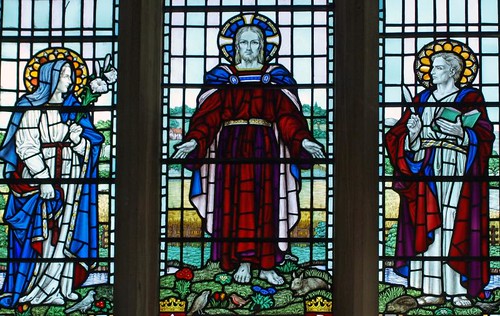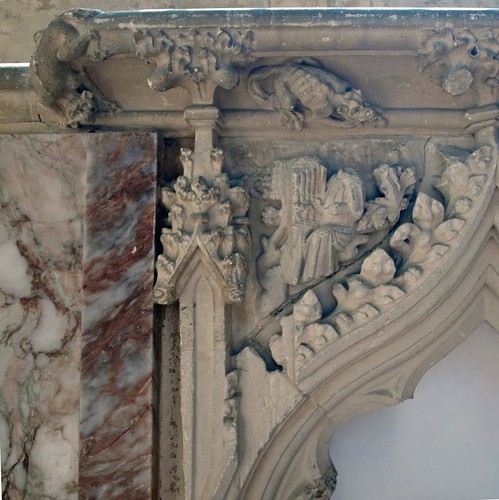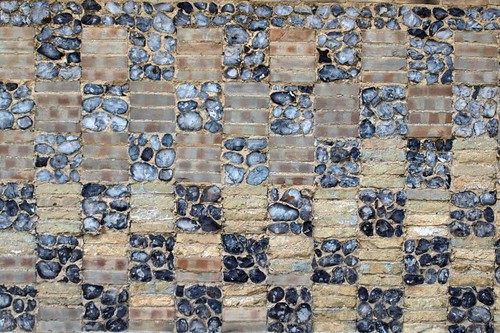The pews have been stripped out and replaced by ugly 1970s chairs, the alabaster Victorian reredos with gauche (and frankly rubbish) statues sits comfortably with a modern window and a fantastic sedilla. It's a hodgepodge of a church mixing the good with the bad and the ugly but was, without doubt, the church of the day.
ST MARY. The early C14 chancel is one of the most splendid monuments of its date in the county. It is four bays long, divided by buttresses into two pairs of two. The buttresses between and the diagonal buttresses at the E end have niches, no doubt for statuettes, a preparation for the show to come. The large N and S windows of three lights have eight different tracery patterns of which at least five are quite unusual and must probably be credited to the imagination of this particular master mason. The E window is unfortunately renewed, and the reredos underneath it (by C. F. Hayward, 1884) by trying to outdo the magnificence of the medieval stonework, in alabaster and naturalistic carving is another blemish. It needed all the Victorian self-confidence not to restrain oneself in the presence of so much ornamental carving as the interior of the chancel displays. The windows are shafted and up the voussoirs rim thick bands of bossy foliage. Between the pairs is a buttress outside, and inside a narrow blank arch with a tall concave-sided gable flanked by thin buttresses. In the third window from the W on the N side one detects owls in the leaves, on the S side squirrels. Moreover the easternmost N window has instead of foliage two chains of little men. They dance, wrestle, play musical instruments, hold each other by their feet. It is all full of indomitable exuberance. On the S side the priest’s door, Sedilia and Piscina make a similar display, five ogee arches separated by triple-shafts, the front part of which is square and diapered, while the side parts are the usual demi-shafts. The spandrels again are full of figures, their heads broken off by vandals. Some are angels making music on the portable organ, psaltery, gittern, organistrum (hurdy-gurdy) and harp. As for the rest of the church, nave, S porch, and W tower are also C14, but seem in their details (especially the nave S windows) later than the chancel. The S porch has on the sides the remains of tracery. The W tower is much repaired in brick. The tower arch is early C16 brick. The N arcade dates from 1826, the chancel arch from 1853. In the N aisle an early C19 wooden gallery, on cast iron shafts. - FONT. C18 on baluster stem. - STAINED GLASS. Minor fragments of tabernacles and leaves in the chancel windows, in situ. The glass in the E window must be c. 1850, and if the REREDOS (see above) errs on the side of showiness, this glass errs on the side of humility. - MONUMENT. Edward Waldegrave d. 1584, and wife, with the usual kneeling figures facing each other.
LAWFORD. A deep valley divides its roadside cottages from those remote on the hill where the church stands above the gleaming waters of the Stour. By the gateway of the church is the gateway of the park of Lawford Hall, a timbered house of Armada days, with oak mullioned windows in its wings and 16th century roundels in its windows. One of the roundels has a delightful figure of St Quirinus in armour and another has St Richard of Chichester in his cope. Standing by great lime trees and ivy covered elms, the 15th century church tower looks venerable. The timbered porch has stood 600 years with a face looking down from the middle of the roof.
It is the white ensign that meets our eyes as we come in, a thrilling one, for it flew at the battle of Jutland on the destroyer Abdiel. The village peace memorial has these fine words:
When the Almighty shook the nations and scattered kings, these Lawford men gave their lives for freedom and justice.
The chancel is famous hereabouts for the marvellous detail of its delicately carved stonework, all the work of a 14th century craftsman. Each of its eight side windows is beautiful with tracery, no two alike, and some of them have fragments of old glass. Above these windows are richly carved arcades with owls and an amazing chain of quaint figures performing a vigorous Morris Dance, some holding each other by the leg or the hair, some playing musical instruments, some with flutes or birds or squirrels. There is a superb sedilia below the windows, ending in a priest’s doorway opening out behind a buttress. The delicate carving below the curves of the arches is magnificent, and, though battered by time, still holds us by its beauty, with tiny figures in the spandrels, crowned heads, and musicians above the priest’s door.
In an arched recess kneels Edward Waldegrave and his wife Joan, both as they were in the days before the Armada; he died when Lawford Hall was new. On a tablet we are told that Dean Merivale was rector here for over 20 years last century; he is remembered by two sorts of people - by sportsmen because he rowed in the first university boat race, and by scholars because he wrote a famous history of the Roman Empire.
It is the white ensign that meets our eyes as we come in, a thrilling one, for it flew at the battle of Jutland on the destroyer Abdiel. The village peace memorial has these fine words:
When the Almighty shook the nations and scattered kings, these Lawford men gave their lives for freedom and justice.
The chancel is famous hereabouts for the marvellous detail of its delicately carved stonework, all the work of a 14th century craftsman. Each of its eight side windows is beautiful with tracery, no two alike, and some of them have fragments of old glass. Above these windows are richly carved arcades with owls and an amazing chain of quaint figures performing a vigorous Morris Dance, some holding each other by the leg or the hair, some playing musical instruments, some with flutes or birds or squirrels. There is a superb sedilia below the windows, ending in a priest’s doorway opening out behind a buttress. The delicate carving below the curves of the arches is magnificent, and, though battered by time, still holds us by its beauty, with tiny figures in the spandrels, crowned heads, and musicians above the priest’s door.
In an arched recess kneels Edward Waldegrave and his wife Joan, both as they were in the days before the Armada; he died when Lawford Hall was new. On a tablet we are told that Dean Merivale was rector here for over 20 years last century; he is remembered by two sorts of people - by sportsmen because he rowed in the first university boat race, and by scholars because he wrote a famous history of the Roman Empire.



No comments:
Post a Comment